13 books about Modern Architectures

Australia
Modern Architectures in History
Harry Margalit
Reaktion Books, 2019
This book tells the story of the architects and buildings that have defined Australia’s architectural culture since the founding of the modern nation through Federation in 1901. That year marked the beginning of a search for better city forms and buildings to accommodate the changing realities of Australian life and to express an emerging, distinctive, and, eventually, confident Australian identity. While Sydney and Melbourne were the settings for many of the major buildings, all states and territories developed architectural traditions based on distinctive histories and climates. Harry Margalit explores the flowering of these many architectural variants, from the bid to create a model city in Canberra, through the stylistic battles that opened a space for modernism, to the idealism of postwar reconstruction, and beyond to the new millennium. Australia reveals a vibrant and influential culture of the built environment, at its best when it matches civic idealism with the sensuality of a country of stunning light and landscapes.
[more]

Brazil
Modern Architectures in History
Richard J. Williams
Reaktion Books, 2009
Set against a backdrop of breathtaking natural beauty, Brazil’s striking modernist architecture has long garnered international acclaim. But these well-known works are not fully reflective of the built environment of Brazil, and with this volume, Richard Williams unearths the rich architectural heritage of Brazil.
Spanning from 1945 through today, the book examines Brazilian architecture beyond the works of renowned architects such as Oscar Niemeyer and the “Carioca” architects of Rio de Janeiro. Williams investigates issues such as the use of historic architecture, the importance of leisure and luxury, the role of the favela as a backdrop and inspiration for development, and the rapid growth of cities. From the designated world heritage site of Brasilia—a capital city that was planned from the ground up—to the installation work of artists such as Hélio Oiticica, Brazil delves into the origins and far-reaching influence of Brazil’s architectural modernism.
At a moment when Latin America is of increasing importance in global business and culture, Brazilwill be an essential read for all scholars of architecture and Latin American history.
[more]

Britain
Modern Architectures in History
Alan Powers
Reaktion Books, 2007
The story of modernism in architecture is international, yet each country adopted the movement in its own unique way, inspired by individual artists and schools and in response to specific social needs and political pressures. Britain explores the British approach to modern architecture, and, with due regard for the separate identities of England, Scotland, and Wales, discusses British modernism from its beginnings to the present day.
Alan Powers gives equal weight to the technical and aesthetic aspects of modernism, as well as its often controversial reception within Britain and around the world. He examines the works of key British architects and delves into the influence of non-British architects within the United Kingdom. Powers then turns his attention to postmodern architecture as a global movement, looking at contemporary efforts to make architecture sustainable and adaptable to the new challenges of urban life.
Thoroughly illustrated with images of the buildings under discussion, advertisements, and other historical photographs, Britain is an authoritative, yet highly accessible, account of twentieth-century British architecture.
Alan Powers gives equal weight to the technical and aesthetic aspects of modernism, as well as its often controversial reception within Britain and around the world. He examines the works of key British architects and delves into the influence of non-British architects within the United Kingdom. Powers then turns his attention to postmodern architecture as a global movement, looking at contemporary efforts to make architecture sustainable and adaptable to the new challenges of urban life.
Thoroughly illustrated with images of the buildings under discussion, advertisements, and other historical photographs, Britain is an authoritative, yet highly accessible, account of twentieth-century British architecture.
[more]
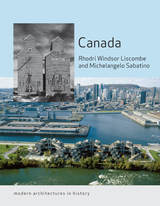
Canada
Modern Architectures in History
Rhodri Windsor Liscombe and Michelangelo Sabatino
Reaktion Books, 2016
Canada is a country of massive size, of diverse geographical features and an equally diverse population—all features that are magnificently reflected in its architecture. In this book, Rhodri Windsor Liscombe and Michelangelo Sabatino offer a richly informative history of Canadian architecture that celebrates and explores the country’s many contributions to the spread of architectural modernity in the Americas.
A distinct Canadian design attitude coalesced during the twentieth century, one informed by a liberal, hybrid, and pragmatic mindset intent less upon the dogma of architectural language and more on thinking about the formation of inclusive spaces and places. Taking a fresh perspective on design production, they map the unfolding of architectural modernity across the country, from the completion of the transcontinental railway in the late 1880s through to the present. Along the way they discuss architecture within the broader contexts of political, industrial, and sociocultural evolution; the urban-suburban expansion; and new building technologies. Examining the works of architects and firms such as ARCOP, Eric Arthur, Ernest Cormier, Brigitte Shim, and Howard Sutcliffe, this book brings Canadian architecture chronologically and thematically to life.
A distinct Canadian design attitude coalesced during the twentieth century, one informed by a liberal, hybrid, and pragmatic mindset intent less upon the dogma of architectural language and more on thinking about the formation of inclusive spaces and places. Taking a fresh perspective on design production, they map the unfolding of architectural modernity across the country, from the completion of the transcontinental railway in the late 1880s through to the present. Along the way they discuss architecture within the broader contexts of political, industrial, and sociocultural evolution; the urban-suburban expansion; and new building technologies. Examining the works of architects and firms such as ARCOP, Eric Arthur, Ernest Cormier, Brigitte Shim, and Howard Sutcliffe, this book brings Canadian architecture chronologically and thematically to life.
[more]
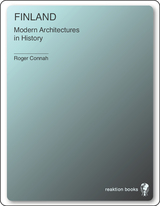
Finland
Modern Architectures in History
Roger Connah
Reaktion Books, 2005
Buildings speak volumes, not just about their occupants or owners, but about the countries in which they exist. From colonnades to paving stones, the architecture of any building does more than simply date the structure—it celebrates the spirit of a people and a nation.
Roger Connah's latest book, Finland, explores the culture and democratic spirit of a country whose buildings carry the indelible markings of Finland's political and physical climate. Nearly all of the country's buildings were constructed after 1917, when Finland gained its independence from Russia. The resulting architecture—often springing from hugely popular public competitions—is emphatically democratic in structure and usage. Finland's extreme northern latitudes, for their part, have given rise to buildings with an acute sensitivity to the physical environment and to the delicate interplay of light and shadow.
From museums to schools to subsidized housing developments, Connah's Finland is an important survey of the country's architecture. Fully illustrated and with detailed examinations of many of the Finnish master architects—including Alvar Aalto—it is also a valuable contribution to the studies of modern architecture and Nordic history.
Roger Connah's latest book, Finland, explores the culture and democratic spirit of a country whose buildings carry the indelible markings of Finland's political and physical climate. Nearly all of the country's buildings were constructed after 1917, when Finland gained its independence from Russia. The resulting architecture—often springing from hugely popular public competitions—is emphatically democratic in structure and usage. Finland's extreme northern latitudes, for their part, have given rise to buildings with an acute sensitivity to the physical environment and to the delicate interplay of light and shadow.
From museums to schools to subsidized housing developments, Connah's Finland is an important survey of the country's architecture. Fully illustrated and with detailed examinations of many of the Finnish master architects—including Alvar Aalto—it is also a valuable contribution to the studies of modern architecture and Nordic history.
[more]
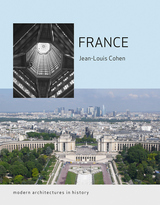
France
Modern Architectures in History
Jean-Louis Cohen
Reaktion Books, 2015
Everyone knows Notre Dame, the Eiffel Tower, and the chateaux of the Loire Valley, but French architects have also produced some of the most iconic buildings of the twentieth century, playing a central role in the emergence and development of modernism. In France, Jean-Louis Cohen presents a complete narrative of the unfolding architectural modernity in the country, grappling not only with the buildings but also with the political and critical context surrounding them.
Cohen examines the developments in urban design and architecture within France, depicting the continuities and breaks in French architecture since 1900 against a broader international background. Describing the systems of architectural exchange with other countries—including Italy, Germany, Russia, and the United States—he offers a new view on the ideas, projects, and buildings otherwise so often considered only from narrow nationalistic perspectives. Cohen also maps the problematic search for a national identity against the background of European rivalries and France’s colonial past. Drawing on a wealth of recent research, this authoritatively written book will challenge the way design professionals and historians view modern French architecture.
Cohen examines the developments in urban design and architecture within France, depicting the continuities and breaks in French architecture since 1900 against a broader international background. Describing the systems of architectural exchange with other countries—including Italy, Germany, Russia, and the United States—he offers a new view on the ideas, projects, and buildings otherwise so often considered only from narrow nationalistic perspectives. Cohen also maps the problematic search for a national identity against the background of European rivalries and France’s colonial past. Drawing on a wealth of recent research, this authoritatively written book will challenge the way design professionals and historians view modern French architecture.
[more]
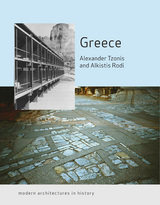
Greece
Modern Architectures in History
Alexander Tzonis and Alcestis P. Rodi
Reaktion Books, 2013
The remains of antiquity define Greek architecture in the popular imagination, but Greek edifices encompass far more than these ancient structures. Offered here is a comprehensive survey of modern Greek architecture of the past hundred-plus years.
The book explores the buildings and architects of modern Greece, ranging from nineteenth-century neoclassical edifices to minimalist contemporary works and urban renewal projects. The ideas driving the creation of these buildings are given full attention, as the authors examine the influence of the rise of Modernism in the arts and the characteristics of regional styles, while also considering the reasons behind the bland, functional structures that have dominated Greek cityscapes since World War II. Greecesituates this design survey within the nation’s tumultuous cultural and political history, including the two world wars, a military dictatorship, civil war, and the consumerist boom of the 1990s.
A penetrating and thorough study, Greece offers a compelling account of modern Greek architecture that will be invaluable for all scholars of design and European history.
[more]

India
Modern Architectures in History
Peter Scriver and Amit Srivastava
Reaktion Books, 2015
A place of astonishing contrasts, India is home to some of the world’s most ancient architectures as well as some of its most modern. It was the focus of some of the most important works created by Le Corbusier and Louis Kahn, among other lesser-known masters, and it is regarded by many as one of the key sites of mid-twentieth century architectural design. As Peter Scriver and Amit Srivastava show in this book, however, India’s history of modern architecture began long before the nation’s independence as a modern state in 1947.
Going back to the nineteenth century, Scriver and Srivastava look at the beginnings of modernism in colonial India and the ways that public works and patronage fostered new design practices that directly challenged the social order and values invested in the building traditions of the past. They then trace how India’s architecture embodies the dramatic shifts in Indian society and culture during the last century. Making sense of a broad range of sources, from private papers and photographic collections to the extensive records of the Indian Public Works Department, they provide the most rounded account of modern architecture in India that has yet been available.
Going back to the nineteenth century, Scriver and Srivastava look at the beginnings of modernism in colonial India and the ways that public works and patronage fostered new design practices that directly challenged the social order and values invested in the building traditions of the past. They then trace how India’s architecture embodies the dramatic shifts in Indian society and culture during the last century. Making sense of a broad range of sources, from private papers and photographic collections to the extensive records of the Indian Public Works Department, they provide the most rounded account of modern architecture in India that has yet been available.
[more]
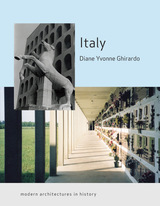
Italy
Modern Architectures in History
Diane Ghirardo
Reaktion Books, 2013
Packed in its dense, historic city centers, Italy holds some of the most prized architecture and art in the world, with which planners and politicians have had to negotiate as they struggle to cope with massive migration from the countryside to the city. Early modern architecture coincided with a sustained drive to transform a country that was still primarily rural into a modern industrial state, and throughout the twentieth century, architects in Italy have attempted to define the role of architecture within a capitalist economy and under diverse political systems. In Italy: Modern Architectures in History, Diane Yvonne Ghirardo addresses these and other issues in her analysis of the last century of Italy’s building practices.
Specifically, she examines the post-unification efforts to identify a distinctly Italian architectural language, as well as the transformation of the urban environment in Italian cities undergoing industrialization in the late nineteenth and early twentieth centuries. She challenges received interpretations of modern architecture and also looks at the subject of illegal building and current responses to ecological challenges. In order to illuminate the full scope of the building industry in Italy, her examples are drawn not only from the work of widely published architects in the largest cities but from throughout the peninsula, including small towns and rural areas.
Insightful reading for those interested in Italian culture, this book offers a new way of understanding the architectural history of modern Italy.
[more]
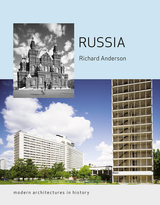
Russia
Modern Architectures in History
Richard Anderson
Reaktion Books, 2015
This book offers a comprehensive account of Russia’s architectural production from the late nineteenth century to the present, explaining how its architecture was both shaped by and came to embody Russia’s rapid cultural, economic, and social revolutions over the past century.
Richard Anderson looks at Russia’s complex relationship to global architectural culture, exploring the country’s central presence in the Rationalism and Constructivism movements of the 1920s, as well as its role as a key protagonist during the Cold War. Looking deeply at Soviet Russia, he brings the relationship between architecture and socialism into focus through detailed case studies that situate buildings and architectural concepts within the socialist milieu of Soviet society. He tracks the way Russian architectural institutions departed from the course of modernism being developed in capitalist countries, and he reappraises the architecture of the Stalin era and the final decades of the USSR. Finally, he traces the influence of Soviet conventions on contemporary Russian architecture—which is now a more heterogeneous mix of approaches and styles— and how it made a lasting and little-known impact on territories extending from the Middle East, to Central Asia, and into China.
A bold new assessment of Russia’s architectural legacy and contemporary contributions, this book is a fascinating exploration of a tumultuous place—and the creativity that has come from it.
Richard Anderson looks at Russia’s complex relationship to global architectural culture, exploring the country’s central presence in the Rationalism and Constructivism movements of the 1920s, as well as its role as a key protagonist during the Cold War. Looking deeply at Soviet Russia, he brings the relationship between architecture and socialism into focus through detailed case studies that situate buildings and architectural concepts within the socialist milieu of Soviet society. He tracks the way Russian architectural institutions departed from the course of modernism being developed in capitalist countries, and he reappraises the architecture of the Stalin era and the final decades of the USSR. Finally, he traces the influence of Soviet conventions on contemporary Russian architecture—which is now a more heterogeneous mix of approaches and styles— and how it made a lasting and little-known impact on territories extending from the Middle East, to Central Asia, and into China.
A bold new assessment of Russia’s architectural legacy and contemporary contributions, this book is a fascinating exploration of a tumultuous place—and the creativity that has come from it.
[more]

Spain
Modern Architectures in History
David Cohn
Reaktion Books, 2022
An investigation of the influences and evolution of modern Spain’s underappreciated, but foundational, architecture.
Spain’s remarkable twentieth-century architecture evolved against a turbulent background of revolution, civil war, dictatorship, and transition to democracy. Architecture played a key role in Spain’s struggle out of poverty and isolation, and its search for identity in the modern world.
This book examines Spanish architecture from the roots of Modernism in the eighteenth and nineteenth centuries to the present, analyzing significant figures and their works in relation to their political, social, and cultural contexts, as well as their contributions to architecture as a whole. From the austere, local Modernism of the 1920s, the influence of international trends in the ’30s, the renewed, “Organicist” Modernism of the ’50s and ’60s, to the flourishing public architecture of the late twentieth century and beyond, Spain provides a penetrating account of the country’s rich and varied built environment.
Spain’s remarkable twentieth-century architecture evolved against a turbulent background of revolution, civil war, dictatorship, and transition to democracy. Architecture played a key role in Spain’s struggle out of poverty and isolation, and its search for identity in the modern world.
This book examines Spanish architecture from the roots of Modernism in the eighteenth and nineteenth centuries to the present, analyzing significant figures and their works in relation to their political, social, and cultural contexts, as well as their contributions to architecture as a whole. From the austere, local Modernism of the 1920s, the influence of international trends in the ’30s, the renewed, “Organicist” Modernism of the ’50s and ’60s, to the flourishing public architecture of the late twentieth century and beyond, Spain provides a penetrating account of the country’s rich and varied built environment.
[more]
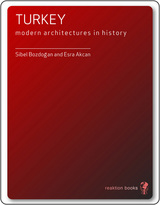
Turkey
Modern Architectures in History
Sibel Bozdogan and Esra Akcan
Reaktion Books, 2012
Turkey: Modern Architectures in History offers a journey through the iconic buildings of Turkey that begins with the end of World War I, when the new Turkish Republic was born out of the disintegration of the Ottoman Empire, includes its democratization in the midst of the Cold War’s competing ideologies, and concludes with the present day, in which Turkey continues to be dramatically transformed through globalization, economic integration, and a renewed appreciation for its Islamic and Ottoman heritage.
Sibel Bozdogan and Esra Akcan explore modern institutional masterpieces and architect-designed buildings through the decades. Their focus includes informal residential plans, and they discuss how these have evolved from small settlements to colossal urban quarters that exist at a slippery threshold of legality. This richly informative history of Turkey’s built environment goes beyond typical surveys of Western modern architecture and is unique in tackling the issue of the modern and contemporary periods that are often omitted in studies of Islamic art and architecture.
Offering a perceptive overview of modern Turkish architecture, this book places it within the larger social, political, and cultural context of the country’s development as a modern nation in the twentieth century.
[more]
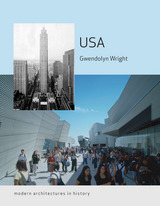
USA
Modern Architectures in History
Gwendolyn Wright
Reaktion Books, 2008
From the Reliance Building and Coney Island to the Kimbell Museum and Disney Hall, the United States has been at the forefront of modern architecture. American life has generated many of the quintessential images of modern life, both generic types and particular buildings. Gwendolyn Wright’s USA is an engaging account of this evolution from the late nineteenth century to the twenty-first. Upending conventional arguments about the origin of American modern architecture, Wright shows that it was not a mere offshoot of European modernism brought across the Atlantic Ocean by émigrés but rather an exciting, distinctive and mutable hybrid.
USA traces a history that spans from early skyscrapers and suburbs in the aftermath of the American Civil War up to the museums, schools and ‘green architecture’ of today. Wright takes account of diverse interests that affected design, ranging from politicians and developers to ambitious immigrants and middle-class citizens. Famous and lesser-known buildings across America come together--model dwellings for German workers in rural Massachusetts, New York’s Rockefeller Center, Cincinnati’s Carew Tower, Frank Lloyd Wright’s Taliesin West in the Arizona desert, the University of Miami campus, the Texas Instruments Semiconductor Plant, and the Corning Museum of Glass, among others--to show an extraordinary range of innovation.
Ultimately, Wright reframes the history of American architecture as one of constantly evolving and volatile sensibilities, engaged with commerce, attuned to new media, exploring multiple concepts of freedom. The chapters are organized to show how changes in work life, home life and public life affected architecture--and vice versa. This book provides essential background for contemporary debates about affordable and luxury housing, avant-garde experiments, local identities, inspiring infrastructure and sustainable design.
A clear, concise and richly illustrated account of modern American architecture, this timely book will be essential for all those who wonder about the remarkable legacy of American modernity in its most potent cultural expression.
USA traces a history that spans from early skyscrapers and suburbs in the aftermath of the American Civil War up to the museums, schools and ‘green architecture’ of today. Wright takes account of diverse interests that affected design, ranging from politicians and developers to ambitious immigrants and middle-class citizens. Famous and lesser-known buildings across America come together--model dwellings for German workers in rural Massachusetts, New York’s Rockefeller Center, Cincinnati’s Carew Tower, Frank Lloyd Wright’s Taliesin West in the Arizona desert, the University of Miami campus, the Texas Instruments Semiconductor Plant, and the Corning Museum of Glass, among others--to show an extraordinary range of innovation.
Ultimately, Wright reframes the history of American architecture as one of constantly evolving and volatile sensibilities, engaged with commerce, attuned to new media, exploring multiple concepts of freedom. The chapters are organized to show how changes in work life, home life and public life affected architecture--and vice versa. This book provides essential background for contemporary debates about affordable and luxury housing, avant-garde experiments, local identities, inspiring infrastructure and sustainable design.
A clear, concise and richly illustrated account of modern American architecture, this timely book will be essential for all those who wonder about the remarkable legacy of American modernity in its most potent cultural expression.
[more]
READERS
Browse our collection.
PUBLISHERS
See BiblioVault's publisher services.
STUDENT SERVICES
Files for college accessibility offices.
UChicago Accessibility Resources
home | accessibility | search | about | contact us
BiblioVault ® 2001 - 2025
The University of Chicago Press









